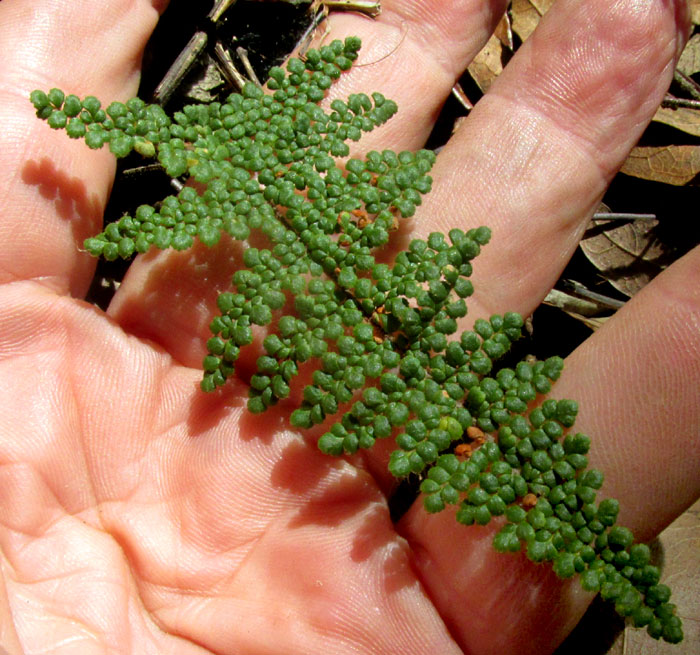Excerpts from Jim Conrad's
Naturalist Newsletter
entry from field notes dated July 29, 2022, taken in an oak forest atop Cerro de la Cruz, elevation ~2885m (~9465 ft), rising on the south side of the community of El Pinar, Amealco de Bonfil, Querétaro, MÉXICO, (~N20.17°, ~W100.17°)
"MEXICAN BEADED LIP FERN"

Near the summit of Cerro de la Cruz, the above fern emerged from a thick layer of last season's oak leaves. Its pinnules, the frond's tiny divisions of divisions, are unusually rounded in form.
Since a body loses most of its heat near its surface, and of all possible forms an object can take, the sphere offers the least surface per unit volume, a good guess is that at this high elevation the pinnules' near spherical form are an adaptation diminishing heat loss and maybe intense UV damage. Also, in this semi-arid region, there's less relative surface area for water loss.
The frond's undersurface seen close-up was even more interesting:
![HEMIONITIS [CHEILANTHES] MEXICANA, frond undersurface with sori](beadfer6.jpg)
Not only are the main water conductors of this fern lavishly coated with unusually long and reddish hairs, but silvery, hoodlike items arising just under the pinnae's curved-under margins hide and shelter the tiny, granular, spore-producing sporangia. I'd never seen such a thing on any fern.
The frond's general triangular form and 2- or 3-pinnate divisions with curved-under pinna margins all is right for the large group of ferns known as lip ferns, genus Cheilanthes. However, in lip ferns, normally the curled-under pinna margins themselves shelter the sporangia, instead of having the sporangia grouped in clusters called sori, spread across the pinnae's undersurfaces. Often the sori are partly covered with papery, silvery indusia. Among the lip ferns, the curled-under "lips" normally covering the sporangia are called "false indusia."
But you can see that in this species the sporangia must be protected by the silvery, pouch-like things, which the experts refer to as false indusia. This fern's false indusia, because they're a little distance away from the curved-under margins, are said to be "inframarginal." Curiously, our fern's false indusia look like "real indusia" of the type often partly covering sori scattered across a pinna's undersurface, as among the spleenworts and woodferns. From the first this species seemed either something other than a Cheilanthes lip fern, or else a very strange lip fern.
The Flora del Bajío, which covers our upland, central Mexico region, has its Cheilanthes lip fern section finished, so I tried it on our fern. I was led to CHEILANTHES MEXICANA, and Internet photos of that species match our find. However, it seems that recent genetic sequencing has shifted the species to a different genus, so that more recent publications refer to it as HEMIONITIS MEXICANA, a name that as of May, 2022 was accepted on the Checklist of Ferns and Lycophytes of the World, with Cheilanthes mexicana noted as a synonym.
However, the species' remarkable "inframarginal false indusia" play little role in accounting for its switch to a different genus. The change is all based on the species' evolutionary history as revealed by their genes. The most obvious physical difference between Cheilanthes and Hemionitis is that Cheilanthes species produce half the number of spores in their tiny sporangia as occur in Hemionitis species. More precisely, Cheilanthes species "have 32 small spores per sporangium when sexual, and 16 large spores per sporangium when apomictic" while species now assigned to Hemionitis "produce 64 small spores per sporangium in sexual individuals and 32 large spores per sporangium in apomicts." The quotations are from the study of Amanda Lee Grusz and Michael Windham in the 2013 work "Toward a monophyletic Cheilanthes: The resurrection and recircumscription of Myriopteris (Pteridaceae)."
Hemionitis mexicana, then, is distributed in the semiarid uplands of northern and central Mexico and Guatemala, at altitudes from 2000-3250m (6500-10,700 feet) -- definitely a high-altitude, cold- and UV-adapted fern.
In mid 2022, the authoritative Flora of North America describes the current taxonomic situation with the Family to which lip ferns belong, the Pteridaceae, like this: "The xeric-adapted [arid-land] members of the family (particularly the cheilanthoids) have undergone extensive parallel and convergent evolution, and they have frustrated attempts to produce a natural generic classification based on macromorphologic characteristics alone." In short, everybody is waiting for more genetic sequencing.
I put the name "Mexican Beaded Lip Fern" in quotation marks because I find no one else using it. Only people serious about ferns know about its existence, and they use the binomial, not any common name. However, a very similar species in North America, occurring along the Mexican border in the uplands of Arizona and western Texas, Cheilanthes lendigera, is known as the Beaded Lip Fern, so our fern with its species name of mexicana almost demands of English Speakers that it be called Mexican Beaded Lip Fern.